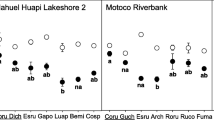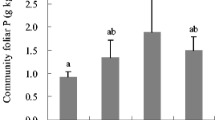Abstract
The nitrogen source utilization by Fagus crenata distributed on soils with different forms of inorganic nitrogen in a cool-temperate deciduous forest in central Japan was determined by measuring foliar δ15N. Two soil habitat types along a slope were delineated based on nitrogen transformation patterns, i.e., soils with high net nitrification rates and with no or low net nitrification, respectively. Despite differences in soil types, the study species, F. crenata, was distributed along the entire slope. The foliar δ15N value of F. crenata from the lower slope area was significantly lower than that from the upper slope. Given the finding of a previous study that the δ15N of NO3− was lower than that of NH4+, our results indicate that reliance on NO3− as a nitrogen source was greater in the lower slope area than in the upper slope area. Differences in the values of foliar δ15N were about 1‰, which is far less than the 10‰ δ15N value of soil inorganic N reported in the previous study. This discrepancy might suggest that the study species utilized NO3− even in the upper site where net nitrification had not been detected. Measurements of nitrate reductase activity, an index of NO3− uptake, also supported this interpretation. Nitrate reduction occurred in leaves and roots at both the lower and the upper sites. Thus, the study species may be able to use NO3− even in soils with no net nitrification, a factor that could allow the distribution of F. crenata along the entire length of the slope.


Similar content being viewed by others
References
Binkley D, Vitousek PM (1989) Soil nutrient availability. In: Pearcy R, Mooney H, Ehleringer J, Rundel P (eds) Physiological plant ecology. Chapman & Hall, London, pp 75–96
Davidson EA, Hart SC, Firestone MK (1992) Internal cycling of nitrate in soils of a mature coniferous forest. Ecology 73:1148–1156
Downs MR, Nadelhoffer KJ, Melillo JM, Aber JD (1993) Foliar and fine root nitrate reductase activity in seedlings of four forest tree species in relation to nitrogen availability. Trees 7:233–236
Enoki T (2003) Microtopography and distribution of canopy trees in a subtropical evergreen broad-leaved forest in the northern part of Okinawa Island, Japan. Ecol Res 18:103–113
Evans RD, Bloom AJ, Sukrapanna SS, Ehleringer JR (1996) Nitrogen isotope composition of tomato (Lycopersicon esculentum Mill. Cv. T-5) grown under ammonium or nitrate nutrition. Plant Cell Environ 19:1317–1323
Garten CT Jr (1993) Variation in foliar 15N abundance and the availability of soil nitrogen on Walker Branch Watershed. Ecology 74:2098–2113
Garten CT Jr, Huston MA, Thomas CA (1994) Topographic variation of soil nitrogen dynamics at Walker Branch watershed, Tennessee. For Sci 40:497–512
Handley LL, Raven JA (1992) The use of natural abundance of nitrogen isotopes in plant physiology and ecology. Plant Cell Environ 15:965–985
Hart SC, Nason GE, Myrold DD, Perry DA (1994) Dynamics of gross nitrogen mineralizations in an old-growth forest: the carbon connection. Ecology 75:880–889
Hirobe M, Tokuchi N, Iwatsubo G (1998) Spatial variability of soil nitrogen transformation patterns along a forest slope in a Cryptomeria japonica D. Don plantation. Eur J Soil Biol 34:123–131
Hirobe M, Koba K, Tokuchi N (2003) Dynamics of the internal soil nitrogen cycles under moder and mull forest floor types on a slope in a Cryptomeria japonica D. Don plantation. Ecol Res 18:53–64
Hobbie EA, Macko SA, Williams M (2000) Correlations between foliar δ15N and nitrogen concentrations may indicate plant–mycorrhizal interactions. Oecologia 122:273–283
Högberg P (1997) Tansley Review No. 95.15N natural abundance in soil-plant systems. New Phytol 137:179–203
Hodge A, Stewart J, Robinson D, Griffiths BS, Fitter AH (2000a) Competition between roots and soil microorganisms for nutrients from nitrogen-rich patches of varying complexity. J Ecol 88:150–164
Hodge A, Robinson D, Fitter A (2000b) Are microorganisms more effective than plants at competing for nitrogen? Trends Ecol Evol 5:304–308
Jackson LE, Schimel JP, Firestone MK (1989) Short-term partitioning of ammonium and nitrate between plants and microbes in an annual grassland. Soil Biol Biochem 21:409–415
Koba K, Tokuchi N, Wada E, Nakajima T, Iwatsubo G (1997) Intermittent denitrification: the application of a 15N natural abundance method to a forested ecosystem. Geochim Cosmochim Acta 61:5043–5050
Koba K, Tokuchi N, Yoshioka T, Hobbie EA, Iwatsubo G (1998) Natural abundance of nitrogen-15 in a forest soil. Soil Sci Soc Am J 62:778–781
Koba K, Hirobe M, Koyama L, Kohzu A, Tokuchi N, Nadelhoffer KJ, Wada E, Takeda H (2003) Natural 15N abundance of plants and soil N in a temperate coniferous forest. Ecosystems 6:457–469
Koyama L, Tokuchi N (2003) Effects of NO3− availability on NO3− use in seedlings of three woody shrub species. Tree Physiol 23:281–288
Lee JA, Stewart GR (1978) Ecological aspects of nitrogen assimilation. Adv Bot Res 6:1–43
Mariotti A, Germon GC, Hubert P, Kaiser P, Létolle R, Tardieux A, Tardieux P (1981) Plant Soil 62:413–430
Masaki T, Suzuki W, Niiyama K, Iida S, Tanaka H, Nakashizuka T (1992) Community structure of a species-rich temperate forest, Ogawa Forest Reserve, central Japan. Vegetatio 98:97–111
Nadelhoffer KJ, Fry B (1988) Controls on natural nitrogen-15 and carbon-13 abundances in forest soil organic matter. Soil Sci Soc Am J 52:1633–1640
Nadelhoffer KJ, Fry B (1994) N isotope studies in forested ecosystems. In: Lajtha K, Michener RH (eds) Stable isotopes in ecology and environmental science. Blackwell, Oxford, pp 22–44
Nadelhoffer K, Shaver G, Fry B, Giblin A, Johnson L, McKane R (1996) 15N natural abundances and N use by tundra plants. Oecologia 107:386–394
Nordin A, Högberg P, Näsholm T (2001) Soil nitrogen form and plant nitrogen uptake along a boreal forest productivity gradient. Oecologia 129:125–132
Ohlson M, Högbom L (1993) Species-specific dynamics in nitrate reductase activity in coexisting swamp forest plants. J Ecol 81:739–744
Osada N, Tateno R, Hyodo F, Takeda H (2004a) Changes in crown architecture with tree height in two deciduous tree species: developmental constraints or plastic response to the competition for light? For Ecol Manage 188:337–347
Osada N, Tateno R, Mori A, Takeda H (2004b) Changes in crown development patterns and current-year shoot structure with light environment and tree height in Fagus Crenata (Fagaceae). Am J Bot 91:1981-1989
Sakai A, Ohsawa M (1994) Topographical pattern of the forest vegetation on a river basin in a warm-temperate hilly region,central Japan. Ecol Res 9:269–280
Shearer GB, Kohl DH (1986) N2 fixation in field settings: estimations based on natural15N abundance. Aust J Plant Physiol 13:699–757
Tateno R, Takeda H (2003) Forest structure and tree species distribution in relation to topography mediated heterogeneity of soil nitrogen and light at forest floor. Ecol Res 18:559–571
Tateno R, Hishi T, Takeda H (2004) Above- and belowground biomass and net primary production in a cool-temperate deciduous forest in relation to topographical changes in soil nitrogen. For Ecol Manage 193:297–306
Tokuchi N, Hirobe M, Koba K (2000) Topographical differences in soil N transformation using15N dilution method along a slope in a conifer plantation forest in Japan. J For Res 5:13–19
Truax B, Lambert F, Gagnon D, Chevrier N (1994) Nitrate reductase and glutamine synthetase activities in relation to growth and nitrogen assimilation in red oak and red ash seedlings: effects of N-forms, N concentration and light intensity. Trees 9:12–18
Vitousek PM, Howarth RW (1991) Nitrogen limitation on land and in the sea: how can it occur? Biogeochemistry 13:87–115
Zak DR, Hairston A, Grigal DF (1991) Topographic influences on nitrogen cycling within an upland pin oak ecosystem. For Sci 37:45–53
Acknowledgements
We would like to thank the Kyoto University Ashiu Forest Research Station for supporting our study. We are very grateful to F. Hyodo, S. Sugiura, A. Mori, H. Ishii, Y. Fukasawa and T. Aikawa for assistance with field and laboratory work and K. Koba and L. Koyama for reviewing a draft of the manuscript. This study was partly supported by a grant (11213205) from the Ministry of Education, Science, Sports and Culture of Japan.
Author information
Authors and Affiliations
Corresponding author
Rights and permissions
About this article
Cite this article
Tateno, R., Osada, N., Terai, M. et al. Inorganic nitrogen source utilization byFagus crenata on different soil types. Trees 19, 477–481 (2005). https://doi.org/10.1007/s00468-005-0409-4
Received:
Accepted:
Published:
Issue Date:
DOI: https://doi.org/10.1007/s00468-005-0409-4




